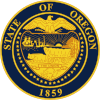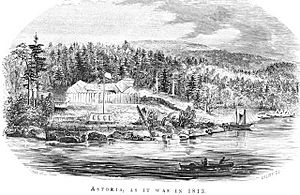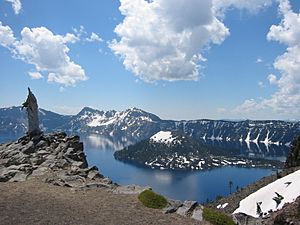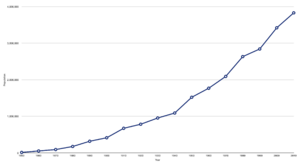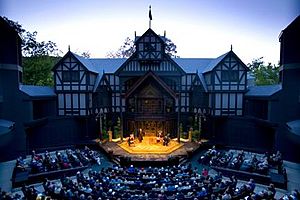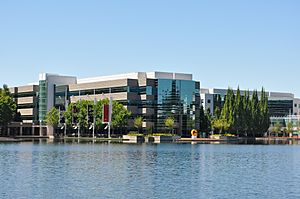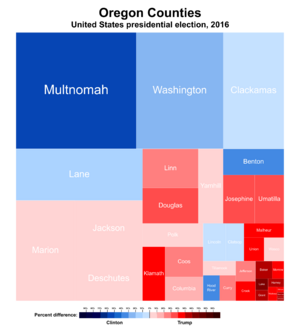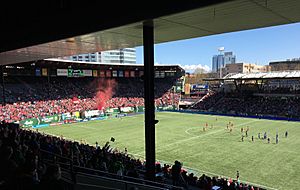Oregon facts for kids
Quick facts for kids
Oregon
|
|||||
|---|---|---|---|---|---|
|
|||||
| Nickname(s):
The Beaver State
|
|||||
| Motto(s):
Alis volat propriis
(English: She flies with her own wings) |
|||||
| Anthem: Oregon, My Oregon | |||||

Location of Oregon within the United States
|
|||||
| Country | United States | ||||
| Before statehood | Oregon Territory | ||||
| Admitted to the Union | February 14, 1859 (33rd) | ||||
| Capital | Salem | ||||
| Largest city | Portland | ||||
| Largest county or equivalent | Multnomah | ||||
| Largest metro and urban areas | Portland | ||||
| Legislature | Legislative Assembly | ||||
| • Upper house | State Senate | ||||
| • Lower house | House of Representatives | ||||
| Judiciary | Oregon Supreme Court | ||||
| U.S. senators | Ron Wyden (D) Jeff Merkley (D) |
||||
| U.S. House delegation | 5 Democrats 1 Republican (list) |
||||
| Area | |||||
| • Total | 98,381 sq mi (254,806 km2) | ||||
| • Land | 95,997 sq mi (248,631 km2) | ||||
| • Water | 2,384 sq mi (6,175 km2) 2.4% | ||||
| Area rank | 9th | ||||
| Dimensions | |||||
| • Length | 360 mi (580 km) | ||||
| • Width | 400 mi (640 km) | ||||
| Elevation | 3,300 ft (1,000 m) | ||||
| Highest elevation | 11,249 ft (3,428.6 m) | ||||
| Lowest elevation
(Pacific Ocean)
|
0 ft (0 m) | ||||
| Population
(2024)
|
|||||
| • Total | |||||
| • Rank | 27th | ||||
| • Density | 39.9/sq mi (15.0/km2) | ||||
| • Density rank | 39th | ||||
| • Median household income | $80,200 (2023) | ||||
| • Income rank | 19th | ||||
| Demonym(s) | Oregonian | ||||
| Language | |||||
| • Official language | De jure: none De facto: English |
||||
| Time zones | |||||
| most of state | UTC−08:00 (Pacific) | ||||
| • Summer (DST) | UTC−07:00 (PDT) | ||||
| majority of Malheur County | UTC−07:00 (Mountain) | ||||
| • Summer (DST) | UTC−06:00 (MDT) | ||||
| USPS abbreviation |
OR
|
||||
| ISO 3166 code | US-OR | ||||
| Traditional abbreviation | Ore. | ||||
| Latitude | 42° N to 46°18′ N | ||||
| Longitude | 116°28′ W to 124°38′ W | ||||
|
|||||
| Dance | Square dance |
|---|---|
| Bird | Western meadowlark (Sturnella neglecta) |
| Fish | Chinook salmon (Oncorhynchus tshawytscha) |
| Flower | Oregon grape (Mahonia aquifolium) |
| Tree | Douglas-fir |
| Insect | Oregon swallowtail (Papilio oregonius) |
Oregon (pronounced ORR-ih-gun) is a beautiful state located in the Pacific Northwest part of the United States. It's known for its amazing natural beauty, from towering volcanoes to deep forests and dry deserts. Oregon shares its northern border with Washington along the Columbia River. To the east, the Snake River separates it from Idaho. Its southern neighbors are California and Nevada, and the vast Pacific Ocean forms its western edge.
For thousands of years, many Native American nations called Oregon home. European explorers and traders first arrived on Oregon's Pacific coast in the 1500s. Famous expeditions, like the Lewis and Clark Expedition in the early 1800s, explored the area. Soon after, the first permanent European settlements were built by trappers and fur traders. In 1846, Oregon officially became part of the United States, and it joined the Union as the 33rd state on February 14, 1859.
Today, Oregon is home to about 4.2 million people. It's the ninth-largest state in terms of land area. Salem is the state capital, and Portland is the largest city. Oregon is famous for its diverse landscapes, including volcanoes, many rivers and lakes, thick forests, and even high deserts. Mount Hood is the state's highest point, reaching over 11,000 feet. You can also find Crater Lake National Park here, which has the deepest lake in the U.S. Oregon's economy has grown from farming, fishing, and logging to include a strong technology industry, especially in the "Silicon Forest."
Contents
- Understanding the Name: Oregon
- Oregon's Past: A Journey Through Time
- Oregon's Geography: A Land of Variety
- Oregon's People: Demographics and Languages
- Oregon's Economy: Industries and Innovation
- Education in Oregon
- Oregon's Government and Laws
- Oregon's Politics
- Sports in Oregon
- Sister Regions
- See also
Understanding the Name: Oregon

The exact origin of the name "Oregon" is a bit of a mystery! There are a few interesting ideas about where it came from.
One idea is that it came from the Spanish word "orejón," which means "big ear." This word might have been used by early Spanish explorers in 1598 to describe the area around the Columbia River. Over time, the "j" sound in Spanish might have changed to a "g" in English.
Another idea suggests the name comes from the Spanish word "orégano," which is a plant that grows in the southern part of the region. Some also think it might be named after a stream in Spain called "Arroyo del Oregón."
An early spelling, Ouragon, was used by Major Robert Rogers in 1765. He was talking about the legendary "River of the West," which we now know as the Columbia River. By 1778, the spelling had become Oregon.
Some people believe the name comes from the French word ouragan, meaning "windstorm" or "hurricane." This could be because Native American stories described strong winds on the lower Columbia River.
Another interesting thought comes from Joaquin Miller, who wrote in 1904 that "Oregon" might come from the Portuguese words Ouve água, meaning "Hear the waters." He felt this name perfectly described the sound of waterfalls near Mount Hood.
A different theory, considered very likely by some, suggests the name came from a mistake on an old French map. A river called "Ouisiconsink" (now the Wisconsin River) was misspelled, making it look like there was a river flowing west named "Ouaricon."
Today, most people in Oregon say the state's name as "or-uh-gun," not "or-ee-gone."
Oregon's Past: A Journey Through Time
First People of Oregon
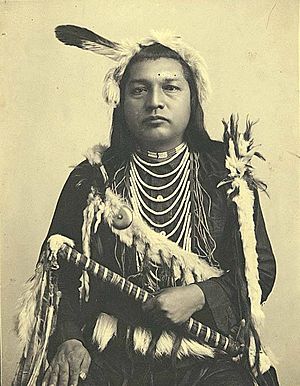
Long, long ago, Paleo-Indians lived in the Oregon region. The oldest signs of people living here were found in Fort Rock Cave and the Paisley Caves. Scientists believe people were here at least 15,000 years ago! By 8000 BC, many settlements existed, especially along the Columbia River and near the coast.
During ancient times, huge floods from a melting glacier in Montana filled the Willamette Valley with hundreds of feet of water. This made the valley very fertile for farming later on.
By the 1500s, many different Native American groups called Oregon home. These included the Chinook, Coquille, Bannock, Kalapuya, Klamath, Nez Perce, and Umatilla tribes, among others.
European Explorers and Early Settlers
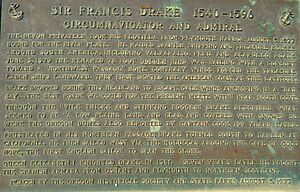
The first Europeans to see Oregon were Spanish explorers in 1543. Later, in 1579, the English explorer Sir Francis Drake briefly stopped near Coos Bay. More Spanish and British explorers, like Captain James Cook, explored the coast in the late 1700s.
In the late 1700s and early 1800s, French Canadians, Scots, and other trappers arrived. Some were part of the famous Lewis and Clark Expedition. They explored the land and traded furs. Many places in Oregon still have French names today, like Malheur Lake and the Deschutes River.
The Lewis and Clark Expedition built a winter fort called Fort Clatsop near the mouth of the Columbia River in 1805. In 1811, John Jacob Astor funded Fort Astoria, which became the first permanent European settlement in Oregon.
For a while, both Britain and the United States claimed the Oregon region. The Treaty of 1818 allowed both countries to occupy the land. The Hudson's Bay Company became very powerful in the fur trade during this time.
The Oregon Trail and Statehood
In 1841, a provisional government was formed by settlers in the Willamette Valley. This was the first public government in the Oregon Country.
Starting in 1842, the Oregon Trail brought many American settlers to the area. The border between the U.S. and British North America was finally settled peacefully in 1846 with the Oregon Treaty. The Oregon Territory was officially created in 1848.
Early Oregon laws included rules about who could live in the territory. These laws aimed to create a community primarily for white settlers. Oregon was admitted to the United States as the 33rd state on February 14, 1859.
Growth and Modern Times
After the American Civil War, railroads helped Oregon's lumber and farming industries grow. Portland became a major city and a center for the lumber industry. Like many busy port cities, Portland faced challenges in its early days.
In 1902, Oregon became the first state to allow citizens to create or approve laws directly through initiatives and referendums. This is known as the "Oregon System."
During World War II, Oregon played a role in building ships and aircraft. In 1945, a Japanese balloon bomb sadly killed six civilians near Bly.
The construction of the Bonneville Dam on the Columbia River in the 1930s provided a lot of hydroelectric power. This helped Oregon's industries grow.
In 1971, Oregon passed the "Bottle Bill," the first law in the U.S. to encourage recycling by requiring a deposit on beverage containers.
Self-service gasoline was not allowed in Oregon from 1951 until August 2023. Now, gas stations can offer self-service, but many still have attendants pump gas for you.
Oregon's Geography: A Land of Variety
Oregon stretches about 295 miles (475 km) from north to south and 395 miles (636 km) from east to west. It covers an area of about 98,381 square miles (254,806 km²), making it the ninth largest state in the U.S.
The highest point in Oregon is Mount Hood, which stands at 11,249 feet (3,429 meters). The lowest point is sea level along the Pacific Ocean. Oregon's average elevation is 3,300 feet (1,000 meters).
Crater Lake National Park is Oregon's only national park. It's home to Crater Lake, the deepest lake in the U.S., reaching 1,943 feet (592 meters) deep. Oregon also claims the D River as the shortest river in the world!
Oregon is divided into eight main geographical regions. In Western Oregon, you'll find the Oregon Coast, the Willamette Valley, the Rogue Valley, the Cascade Range, and the Klamath Mountains. In Central and Eastern Oregon, there's the Columbia Plateau, the High Desert, and the Blue Mountains.
Most of Oregon is in the Pacific Time Zone. However, a large part of Malheur County in the east is in the Mountain Time Zone.
Geology and Landforms
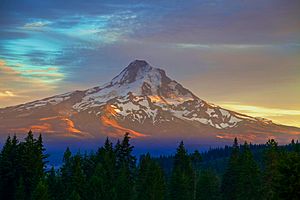
The mountains in Western Oregon, including Mount Hood, were formed by volcanoes. This volcanic activity is due to the Juan de Fuca Plate, a tectonic plate under the Earth's surface. This area can still experience volcanic activity and earthquakes. For example, Washington's Mount St. Helens erupted in 1980, and it was visible from northern Oregon.
The Columbia River is very important to Oregon's geology and history. It's one of North America's largest rivers and cuts through the Cascade Range. About 15,000 years ago, massive floods from the Columbia River shaped much of Oregon. These floods helped create the fertile land in the Willamette Valley.
Oregon's landscape is incredibly varied. It ranges from lush rain forests in the Coast Range to dry deserts in the southeast.
Plants and Animals of Oregon
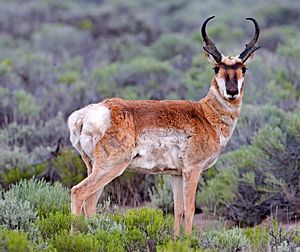
Oregon is home to many unique and diverse animals. About 60% of the state is covered in forests. West of the Cascades, forests are even denser, covering about 80% of the land. Many of Oregon's forests are on federal land. Oregon is a top producer of timber in the lower 48 states.
- Trees: Common trees include the Douglas fir (Oregon's state tree), redwood, ponderosa pine, western red cedar, and hemlock. Ponderosa pines are found more in the eastern Blue Mountains, while firs are common in the west.
- Mammals: You can find many mammals here, such as opossums, shrews, moles, bats, rabbits, pikas, beavers (the state mammal), squirrels, marmots, porcupines, coyotes, wolves, foxes, black bears, raccoons, badgers, skunks, antelopes, cougars, bobcats, lynxes, deer, and elk. Moose arrived in Oregon in the 1960s.
- Marine Mammals: Along the coast, you might see seals, sea lions, humpback whales, killer whales, gray whales, and dolphins.
- Birds: Notable birds include American widgeons, mallard ducks, great blue herons, bald eagles, golden eagles, western meadowlarks (the state bird), barn owls, great horned owls, and pileated woodpeckers.
Oregon is also home to what is believed to be the largest single organism in the world: a giant fungus called Armillaria solidipes that lives underground in the Malheur National Forest.
Oregon has several National Park System sites. These include Crater Lake National Park, John Day Fossil Beds National Monument, Lewis and Clark National Historical Park, and Oregon Caves National Monument.
Oregon's Climate Zones
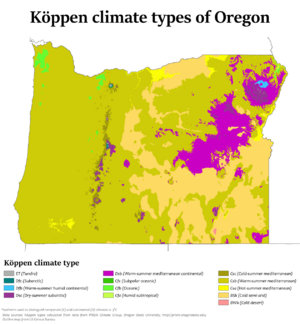
Oregon has a generally mild climate, but it changes a lot across the state. The western part of Oregon, west of the Cascade Range, has an oceanic climate. This means it has dense evergreen forests. The Pacific Ocean greatly influences this area, making winters very wet and summers dry.
The southwestern part of the state, especially the Rogue Valley, has a Mediterranean climate. This means it has drier, sunnier winters and hotter summers, similar to Northern California.
The eastern two-thirds of Oregon, which is mostly high desert, has cold, snowy winters and very dry summers. The Blue Mountains in the east are wet enough to support large forests.
Oregon has milder winters for its latitude compared to many other places in North America. However, it ranks as one of the coolest states in the country during summer. The highest temperature ever recorded in Oregon was 119°F (48°C), and the lowest was -54°F (-48°C).
Major Cities and Towns
|
Largest cities or towns in Oregon
Source: |
||
|---|---|---|
| Rank | Name | Pop. |
| 1 | Portland | 635,067 |
| 2 | Eugene | 177,923 |
| 3 | Salem | 177,487 |
| 4 | Gresham | 111,621 |
| 5 | Hillsboro | 107,299 |
| 6 | Bend | 103,254 |
| 7 | Beaverton | 97,053 |
| 8 | Medford | 85,556 |
| 9 | Springfield | 61,400 |
| 10 | Corvallis | 60,956 |
Most of Oregon's population lives in the Willamette Valley. This valley stretches from Eugene in the south to Portland in the north. Eugene is home to the University of Oregon, and Corvallis is where Oregon State University is located. Salem is the state capital.
Astoria, at the mouth of the Columbia River, was the first permanent English-speaking settlement west of the Rocky Mountains. Oregon City was the first capital of the Oregon Territory.
Bend, located near the center of the state, is one of the fastest-growing cities in the U.S. In southern Oregon, Medford is a growing city with the state's third-busiest airport. Ashland is also in southern Oregon, near the California border. Eastern Oregon is less populated, but Hermiston is its largest and fastest-growing city.
Oregon's People: Demographics and Languages
Population Growth and Diversity
In 2020, Oregon's population was 4,237,256 people. This was a 10.60% increase from the 2010 census. Oregon has been a popular state for people to move to in recent years.
The population is almost evenly split between males (49.5%) and females (50.5%). About 20.5% of the people are under 18 years old.
Oregon is a diverse state. Many people have European ancestry, especially German, Irish, and English. There are also growing communities of Hispanic or Latino, Asian, Native American, and African American people.
Languages Spoken in Oregon
| Rank | Language | Number of Speakers |
|---|---|---|
| 1 | Spanish | 128,303 |
| 2 | Vietnamese | 16,292 |
| 3 | Chinese | 15,816 |
| 4 | Russian | 8,559 |
| 5 | Korean | 4,903 |
| 6 | Ukrainian | 2,534 |
| 7 | Arabic | 1,480 |
| 8 | Tagalog | 447 |
| 9 | Marshallese | 336 |
| 10 | Japanese | 333 |
| 11 | Thai | 169 |
| 12 | French | 142 |
| 13 | German | 139 |
While English is the most common language, many other languages are spoken in Oregon. Spanish is the second most common language. Other languages include Vietnamese, Chinese, Russian, and Korean.
Religious Communities in Oregon
Religious self-identification in Oregon, per PRRI American Values Atlas (2022) Unaffiliated (42%) Protestantism (35%) Catholicism (14%) Mormonism (2%) Judaism (2%) New Age (2%) Jehovah's Witness (1%) Buddhist (1%)
Oregon is known for having a smaller percentage of people who identify with a religious community compared to other U.S. states. Many Oregonians identify as Christian, with the Roman Catholic Church and The Church of Jesus Christ of Latter-day Saints being large groups.
There are also communities of Judaism, Islam, and Buddhism in Oregon, especially in the Portland area. Many people in Oregon also say they have no religious affiliation.
Oregon's Economy: Industries and Innovation
Oregon's economy is strong and diverse. In 2015, Oregon ranked 17th in the nation for median household income. The state's economy has grown steadily over the years.
Farming and Agriculture

Oregon's varied landscapes are perfect for many types of farming. The Willamette Valley has very fertile soil because of ancient floods. This region produces a lot of blueberries.
Oregon is also one of the world's main hazelnut growing areas, producing 95% of the hazelnuts in the United States. The state's wine industry has grown a lot since the 1970s, with hundreds of wineries today.
Along the southern Oregon coast, cranberries are a major crop. In eastern Oregon, farmers grow a lot of wheat. Oregon farmers also raise cattle, sheep, and produce dairy products, eggs, and poultry.
Forestry and Fishing

Oregon has vast forests, which have historically made it a major state for timber production and logging. However, forest fires and changes in forest management have reduced the amount of timber harvested.
Despite these changes, Oregon still leads the U.S. in producing softwood lumber. The state also has one of the largest salmon-fishing industries in the world. Because of its many rivers, Oregon is also a big producer of hydroelectric power.
Tourism and Fun Activities
Tourism is a big industry in Oregon. People love to visit the state's natural wonders, like mountains, forests, waterfalls, rivers, beaches, and lakes. Crater Lake National Park, Multnomah Falls, and the Oregon Caves are popular spots. Mount Hood and Mount Bachelor attract visitors year-round for skiing and other snow sports.
Portland offers many attractions, including the Oregon Museum of Science and Industry, the Portland Art Museum, and the Oregon Zoo. The International Rose Test Garden is also a beautiful place to visit. Portland is famous for its amazing street food and has more breweries than any other city in the world!
The Oregon Coast is also a big draw for tourists. The Oregon Coast Aquarium is a top aquarium in North America. Fort Clatsop has a replica of Lewis and Clark's camp. The Sea Lion Caves are the largest system of sea caverns in the U.S.
In Southern Oregon, the Oregon Shakespeare Festival in Ashland is very popular. Many movies have been filmed in Oregon because of its diverse landscapes, including The Goonies and Kindergarten Cop.
Technology and Innovation
High-tech industries in an area called "Silicon Forest" have been a major employer since the 1970s. Companies like Tektronix and Intel have helped this area grow. Intel, the state's largest private employer, has several large facilities in Hillsboro.
The "Silicon Forest" is home to many tech companies. Major companies like Google, Facebook, and Amazon have built large data centers in Oregon, taking advantage of affordable power and a cool climate.
Major Companies in Oregon
Oregon is home to the headquarters of several large companies. The world headquarters of Nike is located near Beaverton. Adidas Corporation's American Headquarters is in Portland. Harry and David, known for gift items, is based in Medford.
| # | Corporation | Headquarters | Market capitalization (billions US$) |
|---|---|---|---|
| 1. | Nike | Beaverton | 91.35 |
| 2. | FLIR Systems | Wilsonville | 4.77 |
| 3. | Portland General Electric | Portland | 4.05 |
| 4. | Columbia Sportswear | Beaverton | 4.03 |
| 5. | Umpqua Holdings Corporation | Portland | 3.68 |
| 6. | Lithia Motors | Medford | 2.06 |
| 7. | Northwest Natural Gas | Portland | 1.7 |
| 8. | The Greenbrier Companies | Lake Oswego | 1.25 |
The U.S. Federal Government and Providence Health systems are also among the top employers in Oregon.
Taxes and State Budget
Oregon's state budget is about $2.6 billion every two years. Oregon is one of only five states that does not have a sales tax. This means you don't pay extra tax when you buy things.
Because there's no sales tax, the state relies on property and income taxes for its money. Oregon has a "kicker law" that says if the state collects too much income tax, the extra money must be returned to taxpayers.
Most of the state's money (55%) is spent on public education. Other funds go to human services (like child protective services) and public safety.
Education in Oregon
Schools for All Ages
In the 2013–2014 school year, Oregon had 567,000 students in public schools. There were 197 public school districts across the state.
Some of the largest school districts include Portland Public Schools, Salem-Keizer School District, and Beaverton School District. About 90.5% of Oregon high school students graduate, which is higher than the national average.
In 2019, educators across Oregon protested to ask for smaller class sizes, more support staff like counselors and nurses, and more art, music, and physical education classes. These protests led to many schools closing for a day.
Colleges and Universities

Oregon has many great colleges and universities. The state supports seven public universities. The three main public research universities are the University of Oregon (UO) in Eugene, Oregon State University (OSU) in Corvallis, and Portland State University in Portland.

UO is known for its strong academic programs. OSU is the state's only land-grant university and has the largest number of students. It also receives the most funding for research. Portland State University is the second largest in terms of enrollment.
Oregon also has regional universities like Western Oregon University in Monmouth, Southern Oregon University in Ashland, and Eastern Oregon University in La Grande. The Oregon Institute of Technology is in Klamath Falls.
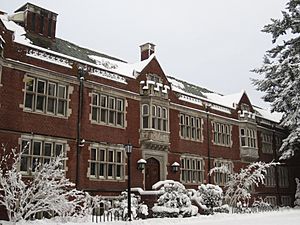
There are also many private colleges in Oregon, especially around Portland. These include the University of Portland, Reed College, Lewis & Clark College, and Pacific University. In Salem, you'll find Willamette University, the state's oldest college.
Oregon's Government and Laws

Oregon's state government works much like the U.S. federal government, with three main parts:
- The legislative branch makes the laws. It has two parts: the Senate and the House.
- The executive branch carries out the laws. This includes the Governor, who is the chief executive. Governors serve four-year terms. Oregon does not have a lieutenant governor; if the governor's office becomes empty, the Secretary of State takes over.
- The judicial branch interprets the laws. It is led by the Oregon Supreme Court, which has seven elected justices.
|
Citizen Power: Ballot Measures
Oregon's constitution allows citizens to vote directly on laws and changes to the state constitution. This is done through ballot initiatives and referendums. Oregon was the first state to adopt this system in 1902.
For example, in 2002, voters approved a measure to increase the state's minimum wage each year based on inflation. In 2004, voters passed a measure that changed land use regulations.
Oregon was also a pioneer in postal voting. Since 1998, all elections in Oregon are conducted by mail, making it one of only two states to do so.
Federal Representation
Oregon is represented by two senators in the U.S. Senate. After the 2020 census, Oregon gained a sixth congressional seat. This means Oregon now has six representatives in the U.S. House of Representatives.
In the U.S. Electoral College, Oregon will cast eight votes in the 2024 presidential election. Oregon has supported Democratic presidential candidates in every election since 1988.
Oregon's Politics
Political opinions in Oregon are often divided by the Cascade Range. Western Oregon tends to be more liberal, especially in the cities of the Willamette Valley. Eastern Oregon is generally more conservative.
However, because the Willamette Valley has more people, its votes usually have a bigger impact on statewide elections. For example, in 2008, the Democratic candidate for Senate won because of strong support in Multnomah County (where Portland is located).
Oregon has a history of adopting electoral reforms. The "Oregon System" allows citizens to have a direct say in laws. This includes things like primary elections to choose party candidates and the ability to recall public officials.
Sports in Oregon
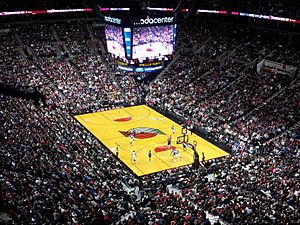
Oregon is home to several professional sports teams. The Portland Trail Blazers play in the NBA. They won the 1977 NBA Finals and have been a popular team for many years. They play at the Moda Center in Portland.
Oregon also has two professional soccer teams: the Portland Timbers of MLS and the Portland Thorns FC of the NWSL. Both teams play at Providence Park in Portland and have very dedicated fans. The Thorns have won three league championships. In 2026, a new WNBA team, the Portland Fire, will start playing in the state.
For baseball fans, there are minor-league teams like the Eugene Emeralds and the Hillsboro Hops.
College sports are also very popular in Oregon. The Oregon State Beavers and the University of Oregon Ducks football teams have a big rivalry game every year. Both universities have also had success in other sports, like baseball and cross country.
Sister Regions
Oregon has special partnerships with regions in other countries:
- Fujian Province,
 People's Republic of China
People's Republic of China - Taiwan Province,
 Republic of China (Taiwan)
Republic of China (Taiwan) - Toyama Prefecture,
 Japan
Japan - South Jeolla Province
 Republic of Korea (South Korea)
Republic of Korea (South Korea) - Iraqi Kurdistan,
 Iraq
Iraq
See also
 In Spanish: Oregón para niños
In Spanish: Oregón para niños




